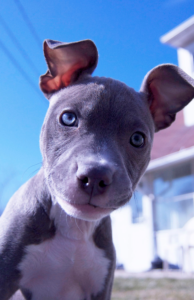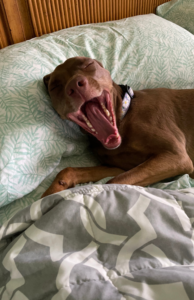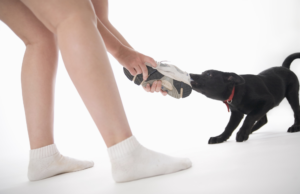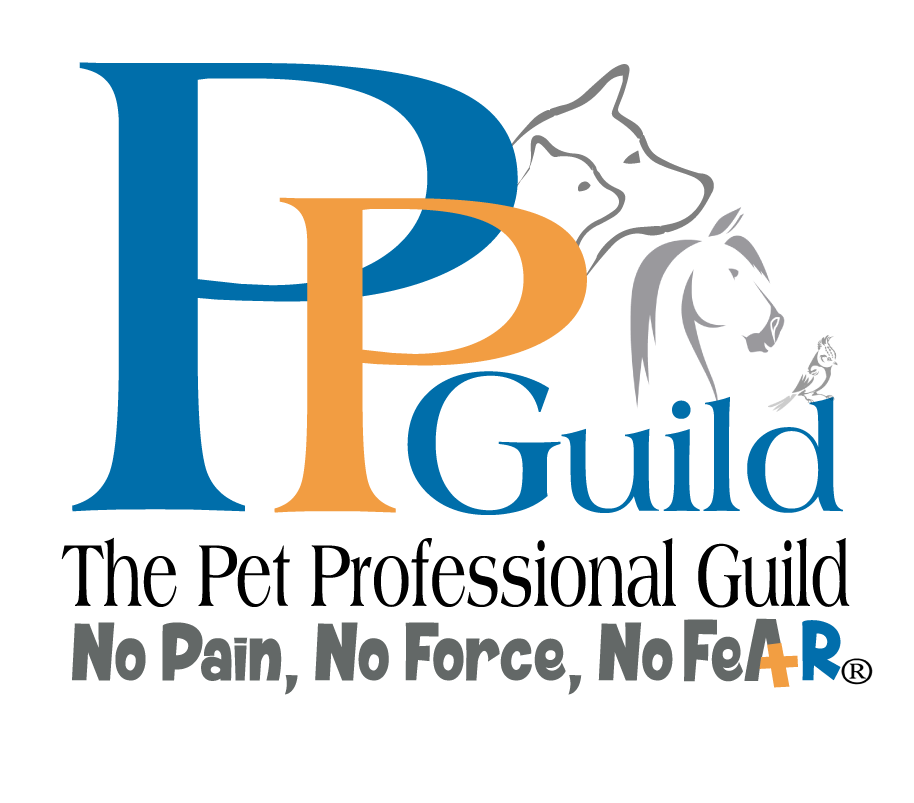How to Tell if Your Puppy is Dominant
Has your puppy done things that make you stop, pause, and caused you to wonder, “is my puppy trying to dominate me”? Are you wondering how to tell if your puppy is dominant? I’m going to ease your mind right at the start. No, your puppy is not trying to be the alpha dog and you don’t need to worry about how to train a dominant puppy.
Are you relieved and confused at the same time? I don’t blame you. For decades there has been so much information (or should I say ‘misinformation’) on dominance and dog pack behavior swirling around. But here’s the truth about dog dominance… it doesn’t exist. It’s not a thing.
Let’s break down a prevalent myth that has caused confusion among puppy parents for years and years. The dominance theory, which suggests that dogs, including puppies, display dominant behaviors to assert their authority, has been perpetuated by outdated information from various sources.
Facts and myths about dominance theory in dogs and puppies
It’s no surprise that the dominance theory has found its way into so many dog guardian’s minds. The internet, TV shows, magazines, books, other dog trainers, some veterinarians, breeders, rescues, and shelters have perpetuated this myth for many decades. It’s no wonder puppy parents all over the world are watching for signs of dominance behavior and are afraid their puppy will start displaying alpha dog behavior.
However, it’s crucial to understand the entire foundation of this theory is deeply flawed.
The dominance theory can be traced all the way back to the 1930s when Rudolph Schenkel conducted research on captive wolves. Unfortunately, the false information came about when Schenkel mistakenly applied his findings to domestic dogs. It’s worth noting that Schenkel later admitted that his own research was flawed and it absolutely did not accurately reflect the behavior of dogs.
Debunking the alpha theory
- Captive Wolf Packs:
Rudolph Schenkel studied wolves that were forced to live together in captivity, often from different packs and unrelated individuals. This led to unnatural social dynamics within the group, because the wolves were not a cohesive family unit. In the wild, wolf packs consist of a breeding pair, their offspring, and sometimes extended family members. This natural social structure is based on cooperation, mutual support, and raising offspring together.
This is important and bears repeating… the natural structure of a wolf pack is based on cooperation, mutual support, and raising offspring together. I really want you to take that in.
-
Stress and Hierarchy:
The captive wolves studied by Schenkel were placed in artificial environments, causing increased stress and competition for limited resources. This resulted in heightened aggression and a distorted view of hierarchy. In the wild, wolf pack hierarchy is more fluid and based on cooperation rather than dominance and submission. The focus is on the well-being of the pack as a whole, not on asserting dominance over one another.
This is another crucial take away… the focus within a wolf pack is on the well-being of the pack as a whole, NOT asserting dominance over each other.
Even though Schenkel debunked his own scientific findings, the dominance theory won’t seem to go away.
Why won’t the alpha dog theory go away?
It’s simple. There are still too many dog trainers and other dog professionals who haven’t kept up on the latest science about dog training and dog behavior. The trainers and professionals have not kept up on continuing education.
I grew up learning about dominance theory and alpha dogs. Heck, I even have books filled with information on this topic. But these books no longer have a place for education and have been replaced by shelves of books and literature with up-to-date information.
I digress… this is a whole other topic in itself.
Let’s look at puppy behavior through a more accurate lens.
Is my puppy being dominant?
Debunking Dominance in Puppy Behavior
Behavior Fluidity and Hierarchy:
A puppy’s behavior is not driven by dominance towards us or other dogs. They are not jockeying for position to the be the alpha dog in any of these relationships.
In fact, canine behavior is fluid, and there is a hierarchy at play within their social interactions. Your puppy may defer to a particular dog in one situation but assert themselves in another.
Interactions with Humans:
Puppies are not exhibiting dominance when they engage in certain behaviors towards humans. Each behavior serves a specific function and is not an attempt to dominate. Let’s explore some common situations that may mistakenly be seen as dominance:
10 Ways Dogs are Being Dominant (well, 10 ways people think their puppy is being dominant)
-
Growling over a bone:
Puppies growl to communicate their desire to protect their resources. It’s an instinctive response rather than an assertion of dominance.
In this situation, a puppy is telling us the bone (or other valuable possession is important to them, and they are afraid of losing it. The growling is a symptom of the underlying behavior which is resource guarding.
- Pulling on the leash:
Puppies pull because they are eager to explore their surroundings, not because they are trying to dominate or be the alpha dog.
The pulling occurs because dogs have 4 legs and we have. We are not as fast and are basically slowing our dogs down. In addition, they are excited to investigate the delightful scents their nose is pulling them towards. Puppies need to be taught to walk at a slower pace so us slow humans can take them for a walk.
- Rushing through the door:
Puppies are naturally excited and curious. They want to explore the world outside and do not view it as a power struggle. It’s a bit like being a kid in a toy store. We can’t’ expect them to not get excited and want to run over and explore all the toys. Our puppies are no different.
They want to go investigate all the great things. It’s a sensory overload for them (and for kids in a toy store). If rushing through the door is something you consider an undesired behavior, teaching puppies door manners and a more desired should be on the menu of skills to teach.
- Ignoring obedience commands:

Puppies are still learning and may get distracted or lack understanding. It’s not a sign of dominance but an opportunity for further training and reinforcement.
Those distractions are a pesky thing. We’ve discussed in previous blogs how distractions make it hard for puppy’s to be able to do the skills we prefer. Puppies aren’t attempting to be the alpha dog by not doing what we ask. They just don’t know how to do the skill at the level of difficulty we are asking and it’s up to us to continue teaching them how to execute the skills at a Jedi Master level.
- Humping or mounting:
This is always a big shock to everyone. These behaviors are mostly displayed during play or as a result of increased arousal or stress, not as a display of dominance.
Let’s kick this thought to the curb. Instead of being concerned how this behavior might look, let’s alter our thoughts and wonder what is causing our puppies to be overexcited, over aroused, or stressed and find a way to help them settle and relax.
- Jumping up and biting or pulling on clothes:
Puppies explore the world with their mouths, and jumping is their way of seeking attention or greeting. It’s not a dominance-related behavior or an attempt to try to assert their position over you.
Jumping is a natural behavior. As humans, we don’t love it, but it is something that all puppies do. Puppies greet each other face to face, sniff and gather information. Puppies gain a lot about us and where we’ve been by sniffing us and our mouths are a long way from the ground. Puppies also jump up because they are so happy to see and well, because they just don’t know any better.
If we want a more desired behavior such as standing with all four paws on the ground, then we need to teach our puppies the preferred behavior. They won’t do it automatically, no matter how much we want them to.
- “Pushy” behavior (pawing or barking):
Puppies exhibit these behaviors to communicate their needs. This is not dominance behavior.
By misunderstanding what the root of this behavior means we risk fracturing our relationships with our puppies. When we have ‘dominance blinders’ on, we view behavior as “Bad” and completely miss what our puppies are trying to tell us. It’s essential to address their underlying needs rather than viewing it as dominance.
“Pushy” puppies are often tired, over stimulated, have to potty, are lacking mental enrichment, and in most cases, are plain ol’ bored.
- Running away or not giving back stolen items:

Puppies are naturally curious and like to engage in playful behavior. When they find something interesting, they often want to chew it. They might run away with the stolen item because we are chasing them… and well… that’s a super fun game for puppies. It’s not a sign of dominance, but rather an opportunity for training and redirection.
If we don’t want puppies to steal things they shouldn’t have, it’s up to use to puppy proof and put our things away. It’s also our job to redirect them to a puppy approved chew. If we expect our puppies to give things back and not run away with them, then we need to teach our puppies that a game of ‘trade’ is more fun than playing keep away.
- Trying to access furniture, counters, and tables:
Puppies explore their environment and are motivated by desire for food or comfort. It’s not an attempt to assert dominance or try to be the alpha.
Jumping on counters
Our puppies olfactory system draws them up to the counters and tables because the aroma of the good stuff pulls them towards.
If we want to reduce the chances of our puppies counter surfing, we need to provide them with puppy approved foraging games to keep their interest on the floor (stuffed KONGs and food puzzles are great for this).
Getting on furniture
They get on our furniture because it is more comfortable than the floor or carpet, and yes, even more comfortable than the dog bed we’ve purchased. Sometimes our furniture offers a better vantage point for our puppies to see the world around them.
If we prefer our dogs don’t sleep on our furniture, then we need to ensure we have a comfy dog bed (they are not all created equal. Have you ever been mattress shopping? You know they aren’t all the same) and teach them where our preferred sleeping spot for them is.
We also need to use management to keep them from practicing the unwanted behavior.
The Harmful Impact of the Dominance Mindset
Believing that your puppy is dominant can be detrimental to your relationship. It may lead to punishment-based training techniques and misunderstandings about your puppy’s intentions. Here’s why adopting a different perspective is crucial:
- Relationship damage: Viewing your puppy as dominant may create a power struggle instead of a cooperative and loving bond.
- Alpha roll and mimicry: Attempting to mimic dominance-related behaviors, such as alpha rolls, is not only ineffective but also harmful. Dogs know full well that we are not fellow dogs, and mimicking such behaviors can be confusing, scary, and damage trust between you and your puppy.
Remember, your puppy’s actions are not driven by a desire for world domination (even if the movie Cats & Dogs had fun portraying it that way) but rather by instinct, curiosity, and communication. By recognizing and addressing their needs, you can build a strong, trusting, and mutually rewarding relationship with your furry companion.
The American Veterinary Society of Animal Behavior has a position statement on the dominance theory.
Dogs Aren’t Wolves
We do a disservice when we compare our dogs to wolves.
It’s important to note that dogs, including puppies, have been domesticated for thousands of years and have distance behaviors shaped by breeding and their interactions with humans. The puppy sitting next to you on the couch is so far removed from their wolf ancestors.
Domestication and Social Behavior
Dogs have undergone significant genetic and behavioral changes during domestication. Their social behavior has evolved to form strong bonds with humans and adapt to living in human environments. Their behavior is influenced by a combination of genetic predispositions and environmental factors.
Don’t Cry Wolf!
You are literally in charge of every single thing in your puppy’s day. They are totally reliant on you. Now, who is the dominant one?? Think about for a minute… you are!
Final words on “alpha dogs’ and puppies being ‘dominant”
Puppies, like their adult counterparts, exhibit fluid behavior and adaptability. They learn through exploration, play, and interactions with their environment and humans. Their behavior is not driven by dominance but rather by natural instincts, curiosity, and their desire to communicate and engage with their surroundings.
Ready to discover the truth about puppy behavior and get help with training? Yes, I’m looking for expert guidance on puppy training for a harmonious household.












